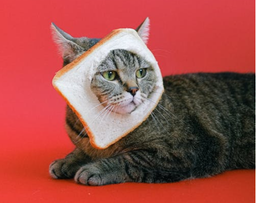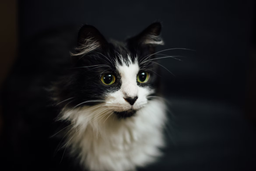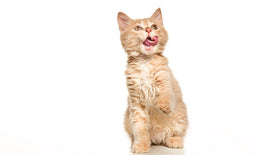The best food for cats with no teeth—is dry food even an option?
Cat parents often lose sleep over what to feed their toothless felines. Am I buying the right texture of food? Is there a special food for cats with no teeth? Should I transition my kitty to a liquid diet?
A common misconception is that toothless cats cannot chew and consequently face digestion issues, which is untrue! The reality is, edentulism—that’s the precise medical term for toothlessness—isn’t a debilitating condition for felines. With the right food and proper care, you can ensure your cat lives (and eats) to the fullest!
In this guide, we will suggest suitable meals for cats with weak or no teeth. We’ll also address crucial issues around dental hygiene and introduce you to Untamed’s wet food products that support overall health in felines.
The feline dental anatomy—why teeth are crucial for cats
Humans need teeth to chew, but cats primarily use them as hunting weapons and not to grind food. Feline dental anatomy reflects their predatory needs. They have pointy incisors and canines to hold and kill prey, while their molars and premolars help them tear down flesh into small, swallowable pieces.
Teeth are also not necessary for digestion in felines. Since cats don’t really chew their food often, their digestive system has adequate enzymes to process unchewed raw meat.
Besides hunting, cats also use teeth to:
- Pick up food or other items
- Nibble at objects to relieve anxiety
- Groom themselves (their tiny front teeth are pretty effective in untangling matted hair and brushing out pesky ticks, fleas, and anything else accumulated on their coats)
What happens when a cat has no teeth—does it impact how they eat?
The impact of having no teeth is different for domesticated and wild cats. While indoor cats may do well without teeth because they're not hunting, losing teeth is practically a death sentence for their cousins in the wild who hunt for survival.
As far as eating is concerned, cats can do fine without teeth because of their multi-purpose and super elastic tongue. The feline tongue has a bunch of tiny spikes or hooks—called papillae—that work together like velcro to brush out dead hair while grooming. The papillae are essential to toothless cats, helping push food into their oral cavity without using teeth!
While gobbling up food is no trouble for toothless cats, you should ensure that their food is bite-sized and easy to swallow.

The zen floss-ophy for cats with no teeth—don’t worry, human, we don’t need them that much—just do the hunting in our stead, eh?
Source: Nathan Fertig
What to look for in food for cats with no teeth
You probably won’t find any special food for toothless cats in UK stores as they manage well with standard types of cat food. It’s up to you to determine whether a particular product is appropriate for your feline. While buying any food for a cat with dental issues, you should consider the following:
- Whether the texture of the product is convenient or acceptable to your cat
- If it fulfils the nutritional requirements
What type of food or food texture works for toothless cats?
Vets recommend giving soft (wet) food to cats with no teeth. The moisture content in food varies significantly depending on the type. Here’s a quick overview of the moisture levels in common complete and complementary products available on the market:
|
Type of food |
Moisture content |
|
Dry food insect proteins) |
6–10% |
|
75–80% |
|
|
60–65% |
Another important factor is your cat’s personal preference. Cats can be notoriously finicky about food textures, even more so when they are toothless. Let’s look further into how different food textures work for cats.

I’m NOT making a mess—it’s called strategic eating when you have to manoeuvre every biscuit to stop it from hurting your gums.
Source: Konstantinos Feggoulis
Dry food for toothless cats
Dry food may be difficult to eat for cats who had their teeth taken out recently, but with time, most toothless cats can swallow kibbles without trouble, although finishing a dry meal may take longer. Biscuits have a coarse texture that can hurt bare gums, so cats with no teeth are more careful while swallowing them.
As a primary precautionary measure, vets recommend observing your toothless cat for at least 24 hours after giving them dry food for the first time. If they digest it fine, you can add it to their diet.
Remember that nutritionists do not recommend a dry food dominant diet for any cat, let alone a toothless one. Cats on dry food may suffer from dehydration, the root cause of severe problems like IBS (irritable bowel syndrome), constipation, and excessive regurgitation.
If you give dry food to a feline with few to no teeth, try softening up the cat biscuits with unseasoned clear soups and meat or bone broths. It’s better to switch to a wet food diet or mix wet and dry food to make swallowing easier for your toothless friend.
Wet or canned food for toothless cats
Wet or canned food is a breeze to swallow and gentle on the gums, making it convenient for any cat bogged down by dental problems. Besides the apparent hydration benefits, quality wet food hardly ever causes stomach upsets in felines (as it mimics their natural diet).
As nutritionists recommend, wet food rich in animal protein and low in carbs should always be the first choice for all felines, irrespective of breed or age. If your cat was already on a wet food diet before losing their teeth, there’s no need to modify their diet (texture-wise).
Should I prefer pâte or liquefied food textures for my toothless cats?
A common misconception about toothless cats is that they do better with pulpy or liquid consistencies. Many cat parents buy pâte food or run chunky wet food through the blender to get that gooey texture. This step, though thoughtful, is unnecessary as chewing has never been a priority for cats.
Parents of toothless cats have noticed that pâte sticks to the roof of their mouth while eating, making poor felines retch and reject food. Cats without teeth are more comfortable with soft, flaky meat textures rather than paste. Minced or shredded meat in gravy or jelly is the best option for a toothless cat.

Life’s simpler when you’ve got easy-peasy wet food gliding down your throat. Good job, human!
Source: Abeer Zaki
The ideal nutrition in food for no-teeth felines
The nutritional or caloric needs of cats don’t change when they lose their teeth. The following micronutrients should always be present in their diet:

If you’re confused why carbs are not on the list, it’s because cats don’t need them. As far as calories are concerned, a cat should get at least 90 per cent of their calories from proteins and fats. Cats can eat and digest carbs, but they shouldn’t go over 10 per cent of your kitty’s daily calorie intake. Indoor cats, including spayed or neutered felines, need about 180–250 calories per day.
Cat food for old cats with no teeth
Buying food for a senior cat with no teeth can feel even more overwhelming if they are suffering from common age-related health conditions like:
- Diabetes
- Arthritis
- FLUTDs (like cystitis, struvite stones, and UTIs)
- Hyperthyroidism
If your toothless senior suffers from other illnesses, opt for wet food with:
- Quality meat proteins, and not hard-to-digest scraps like animal derivatives or cheap, rubbery meat
- No carbs, which means no grain, starch, or sugar
- No known allergens
These points are relevant for all cats and not only toothless old-timers. While substandard cat food may not immediately harm a healthy adult cat, it will impact their well-being as they age. Cat parents who start feeding nutritionally optimised food to cats from kittenhood save money on vet bills down the line.
Looking for the best food for toothless cats? Try Untamed!
Not sure what food would work best for your toothless moggy? Give Untamed a chance! Our gravy and jelly food are made with premium quality human-grade whole meats cut as flavourful, soft, and bite-sized morsels that are easy to swallow and digest. All our products are hormone-, sugar-, and grain-free.
Our recipes are made in cooperation with vets to ensure your cat gets the right dose of appropriate amino acids, vitamins, minerals, and antioxidants which they need to thrive.
The problem with many cat food products is that they are heavily processed, and the heat depletes the potency of essential nutrients. At Untamed, we don’t obsess over mass-production and rely on gentle steam-cooking to create tasty, wholesome food that preserves the biological availability of nutrients for your precious feline.
We’d love to hear more about your cat—click here to take our TRY NOW quiz and fill us in on your cat’s likes and dislikes to get your first trial pack!

Wet food with terrific taste and tender texture—Untamed is the hip & reliable mate for all cats!
Image (c) Untamed
Why Untamed is the new favourite of all cats!
Untamed is tailored to follow the natural feline feeding patterns. Our team has noticed the wonders of switching to a whole meat diet, especially for ailing cats (which inspired us to start making our cat food)!
Here are some of the benefits of Untamed, as reported by our satisfied clients:
- Seamless digestion—You’ll notice your cat pooing better within one week of switching to Untamed. The natural ingredients in our products are highly digestible, which means there's less mess in the litter tray!
-
Shiny coat—Quality proteins play a crucial role in optimising coat health and minimising hairballs, and our products offer two times more than the industry average. We use the following delicious ingredients:
- Chicken breast and liver
- Tuna steak
- Salmon fillet
- Sardine and mackerel fillet
- Duck breast
- Shrimp
- Weight management—All Untamed cans are perfect serving sizes, making them ideal for cats who tend to overeat. Our protein-loaded products provide energy without hurting the waistline. They are also adequate for weaned-off kittens trying to gain healthy weight
- Healthy ageing—Our carb-free, protein-rich products are great for keeping age-related illnesses, like feline diabetes, at bay. Our food boosts the natural immunity of cats, keeping them fit throughout life
- No allergic reactions—We don't use any known allergens for our meals, so our products are suitable for kittens who have sensitive tummies and are prone to diarrhoea, which can be life-threatening for younglings
How to order your first Untamed taster pack
Untamed simplifies your online cat food shopping experience by offering free deliveries for all our products. Here’s how to get your first trial taster pack delivered to your doorstep:
- Complete our TRY NOW quiz
- Choose a meal plan
- Place the order
Once you exhaust the trial pack, we'll start delivering the goods around the same time every month. With us, you enjoy an easily adjustable cat food delivery service. You can cancel, postpone, or freeze an order any time—no questions asked!
We use recyclable packaging to ensure our operations are ethical and we leave a minimal carbon footprint.

Sniff, lick, chew or gulp, and it’s gone—our aromatic food disappears from plates just like that!
Image (c) Untamed
Can I give homemade food to cats with no teeth?
You can give homemade meals and snacks to toothless cats as long as you follow the dos and don’ts of what cats eat. Here are some common mistakes cat parents tend to make:
- Going overboard with milk—Many cat parents start overfeeding milk to their toothless cats, thinking it is a nutritious snack that can be slurped easily. It is a bad idea because milk and dairy products are full of carbs and hard to digest
- Giving uncut raw food—A.R.F. diets may be popular with some cat parents, but giving large pieces of raw chicken, fish, or bones is a choking hazard for cats with no teeth
- Using fruits as snacks—Cats don’t have enough digestive enzymes to break down the cellulose content in fruit. Since toothless cats won’t be able to chew fruits, it’s smarter to avoid giving them bananas, strawberries, guavas, etc. The same goes for feeding them raw vegetables
Why do cats lose teeth?
It’s natural for kittens to start losing their deciduous or baby teeth when they're around three months old—it's no cause for alarm. But if an adult cat is losing teeth, it's a sign of teeth and gum diseases and progressing age. Oral injury or trauma can also lead to sudden teeth loss.
Dental and gum diseases in felines—how bad can they get?
According to studies, more than 50 per cent of cats older than four suffer from some form of dental and gum disease. The most common are:
- Gingivitis—The inflammation along the lining of gums caused by heavy calculus build-up in teeth. It is a painful condition but usually reversible with antibiotics and oral care. Keep in mind unchecked gingivitis will progress into periodontitis
- Periodontitis—Uncontrolled gingivitis in cats worsens to damage the teeth supporting tissues, causing periodontitis. It’s an irreversible condition leading to the loss of teeth in the affected areas. In chronic cases, the infection spreads to other parts of the body, triggering heart, liver, or kidney failure
- Tooth resorption (TR)—TR happens when the body starts rejecting one or more teeth as a self-defence mechanism. It is the most common cause of complete toothlessness in felines of all ages. The condition begins with the gradual internal destruction of the teeth, till they eventually wither away in fragments. While the exact cause of TR is hard to pinpoint, vets believe that vitamin and mineral imbalances trigger the disease. Siamese, Persians, and Abyssinians are more prone to tooth resorption
Oral diseases in cats can be detected and treated early on. As cat parents, you can be on the lookout for the following symptoms:
- Tender and bleeding gums
- Red lesions around the mouth
- Discolouration in teeth
- Foul breath
- Mouth sensitivity
- Food aversion and weight loss
- Excessive drooling
- Constant pawing at face (due to pain and discomfort)
- Stomach sensitivity and diarrhoea (due to dental infections)
Why are senior cats more prone to dental problems?
Senior cats tend to suffer from various teeth and gum issues more often, but it’s not because the diseases magically appear when they’re old. In most cases, the onset of tooth decay happens during early adulthood but remains undetected. Since the immunity weakens with age, symptoms like loss of appetite and anorexia become apparent. According to vets, most feline dental diseases can be prevented by:
- Regular dental care at home
- Professional teeth clean-ups
- A balanced diet
Toothlessness doesn’t impact longevity in felines, although their quality of life may be compromised if they eat nutritionally deficient food.

I may be toothless, but I identify as smort, cute, and strong because I eat only the best!
Image (c) Untamed
Tooth extraction for cats—should I go for it?
Many cat parents hesitate to have their cat’s bad teeth pulled out because they fear it would make eating impossible. According to feline oral hygienists, letting your cat live with wobbly or rotting teeth can be incredibly painful for them. Since untreated dental infections can lead to organ damage in severe cases, it’s better to get the teeth extracted as it doesn't seriously affect their eating habits.

![Best food for Ragdoll cats in the UK [Broken Down]](http://untamed.com/cdn/shop/articles/featured_best_food_for_ragdoll_cats_uk.jpg?v=1646818249&width=256)

